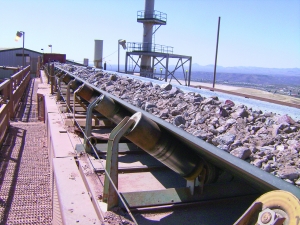


(Posted on 01/05/20)
In bulk material handling applications, a conveyor is typically a massive, complex and extremely powerful system. It’s usually constructed of rubber belting, set on rolling idlers, wrapped around large steel drums at each end and driven by a high-torque motor. As such, a conveyor presents enough danger zones that the entire system should be considered a hazard.
In most applications, a conveyor belt moves at a relatively constant speed, commonly running somewhere between 0.5 and 10 meters per second [≈100 to 2000 fpm]. An Olympic sprinter has a reaction time of about 0.18 seconds (roughly one-fifth of a second) when poised at the starting line and totally focused on the race. If this athlete becomes tangled in a conveyor belt traveling 1.5 meters per second [≈300 fpm], the person would be carried 0.27 meters [≈10.6 inches] before even realizing what has happened.
A ‘regular’ worker would likely require a longer time to react. For simplicity’s sake, we can assume it would be twice the athlete’s reaction time, so the worker would be pulled twice as far, introducing the potential to strike many more components or to be pulled farther and harder into the first one. In addition, most conveyors are engineered with the ability to start remotely. The system may go from dormant to active at any time at the push of a button, and that ability can suddenly catch a worker unaware, leading to serious injury or death.
“When a conveyor belt is moving, there will usually be more tension on the carrying side,” observed Martin Engineering Process Engineer Dan Marshall. “If the conveyor is merely stopped and de-energized, that tension may remain in the belt in the form of stored energy.”
Marshall reminded that a system under tension will always try to approach equilibrium; that is, it will try to release the energy. This release will likely come in the form of a pulley slip, which occurs when the belt slides around the head pulley to equalize the tension. The distance the belt will move is proportional to the amount of tension stored and the belt’s modulus (elasticity), possibly several feet. If a worker is on the belt or close enough to be pulled in during this sudden release of energy, injuries or death can occur.
“There’s a simple rule of thumb regarding conveyors: If it’s moving, don’t touch it,” Marshall continued. “The most common way to prevent inadvertent contact is with suitable guarding that renders the moving components inaccessible.” For maintenance or repairs, procedures for lockout/tagout/blockout/test-out should always be followed when working on a stationary conveyor, and systems should be equipped with anti-rollback devices (also known as backstops) on the head pulley.
Superior Industries, Inc., a US-based manufacturer and global supplier of bulk material processing and... Read more
RightShips’ EVDI methodology is familiar to most drybulk ship owners, with chartering customers... Read more
Thordon Bearings has delivered its COMPAC water-lubricated propeller shaft bearing solution to the final... Read more
ShipMoney, the innovative digital payments platform for the maritime industry, has announced the appointment... Read more
The global market for mobile harbour cranes has seen Liebherr rise to prominence, thanks to the consistent... Read more
Thordon Bearings has unveiled a new wireless propeller shaft bearing wear measurement system, marking... Read more
Global HR, payroll, and crew management software specialist Adonis under the Ripple Operations brand... Read more
A consortium, including technology group Wärtsilä, will develop a new system for the maritime... Read more
Kawasaki Kisen Kaisha, Ltd. and Inmarsat Maritime, a Viasat company, have announced that “K&rdquo... Read more
In order to remain ahead of its time, J. MÜLLER Weser GmbH & Co. KG has received the first... Read more